Trends in Antidepressant, Anxiolytic, and Cannabinoid Use Among Italian Elite Athletes (2011–2023): A Longitudinal Anti-Doping Analysis
Abstract
1. Introduction
2. Materials and Methods
3. Results
4. Discussion
4.1. Pharmacotherapy of Depression in Athletes
4.2. Pharmacotherapy of Anxiety in Athletes
4.3. Discussion of Results: Trends in Antidepressants, Anxiolytics, and THC
4.4. Limitations and Future Perspectives
5. Conclusions
Author Contributions
Funding
Institutional Review Board Statement
Informed Consent Statement
Data Availability Statement
Conflicts of Interest
Abbreviations
| AAPC | Average Annual Percent Change |
| AIFA | Agenzia Italiana del Farmaco |
| CBD | cannabidiol |
| CMAS | Confédération Mondiale des Activités Subaquatiques |
| COVID-19 | Coronavirus Disease 19 |
| DSA | Discipline Sportive Associate |
| EPS | Enti di Promozione Sportiva |
| FH2023 | first half of 2023 |
| FSN | Federazioni Sportive Nazionali |
| OECD | Organization for Economic Co-operation and Development |
| PTSD | post-traumatic stress disorder |
| SNRIs | serotonin–norepinephrine reuptake inhibitors |
| SSRIs | selective serotonin reuptake inhibitors |
| TCAs | tricyclic antidepressants |
| THC | delta-9-tetrahydrocannabinol |
| TUE | Therapeutic Use Exemption |
| WADA | World Anti-Doping Agency |
| WADC | World Anti-Doping Code |
References
- GBD 2019 Mental Disorders Collaborators. Global, Regional, and National Burden of 12 Mental Disorders in 204 Countries and Territories, 1990–2019: A Systematic Analysis for the Global Burden of Disease Study 2019. Lancet Psychiatry 2022, 9, 137–150. [Google Scholar] [CrossRef]
- Vos, T.; Lim, S.S.; Abbafati, C.; Abbas, K.M.; Abbasi, M.; Abbasifard, M.; Abbasi-Kangevari, M.; Abbastabar, H.; Abd-Allah, F.; Abdelalim, A.; et al. Global Burden of 369 Diseases and Injuries in 204 Countries and Territories, 1990–2019: A Systematic Analysis for the Global Burden of Disease Study 2019. Lancet 2020, 396, 1204–1222. [Google Scholar] [CrossRef]
- Santomauro, D.F.; Mantilla Herrera, A.M.; Shadid, J.; Zheng, P.; Ashbaugh, C.; Pigott, D.M.; Abbafati, C.; Adolph, C.; Amlag, J.O.; Aravkin, A.Y.; et al. Global Prevalence and Burden of Depressive and Anxiety Disorders in 204 Countries and Territories in 2020 Due to the COVID-19 Pandemic. Lancet 2021, 398, 1700–1712. [Google Scholar] [CrossRef]
- Pastorino, G.M.G.; Marino, M.; Aiello, S.; D’Auria, R.; Meccariello, R.; Santoro, A.; Viggiano, A.; Operto, F.F. COVID-19 Pandemic: 1-Year Follow-Up in Children and Adolescents with Neuropsychiatric Disorders. Int. J. Environ. Res. Public Health 2023, 20, 3924. [Google Scholar] [CrossRef]
- Ruggiero, M.; Motti, M.L.; Meccariello, R.; Mazzeo, F. Resveratrol and Physical Activity: A Successful Combination for the Maintenance of Health and Wellbeing? Nutrients 2025, 17, 837. [Google Scholar] [CrossRef] [PubMed]
- Schuch, F.B.; Vancampfort, D.; Firth, J.; Rosenbaum, S.; Ward, P.B.; Silva, E.S.; Hallgren, M.; Ponce De Leon, A.; Dunn, A.L.; Deslandes, A.C.; et al. Physical Activity and Incident Depression: A Meta-Analysis of Prospective Cohort Studies. Am. J. Psychiatry 2018, 175, 631–648. [Google Scholar] [CrossRef]
- Christiansen, H.; Hirsch, O.; Albrecht, B.; Chavanon, M.-L. Attention-Deficit/Hyperactivity Disorder (ADHD) and Emotion Regulation Over the Life Span. Curr. Psychiatry Rep. 2019, 21, 17. [Google Scholar] [CrossRef]
- Mazzeo, F. Current Concept of Obesity. Sport Sci. 2016, 9, 42–48. [Google Scholar]
- Castaldelli-Maia, J.M.; Gallinaro, J.G.d.M.E.; Falcão, R.S.; Gouttebarge, V.; Hitchcock, M.E.; Hainline, B.; Reardon, C.L.; Stull, T. Mental Health Symptoms and Disorders in Elite Athletes: A Systematic Review on Cultural Influencers and Barriers to Athletes Seeking Treatment. Br. J. Sports Med. 2019, 53, 707–721. [Google Scholar] [CrossRef]
- Reardon, C.L.; Hainline, B.; Aron, C.M.; Baron, D.; Baum, A.L.; Bindra, A.; Budgett, R.; Campriani, N.; Castaldelli-Maia, J.M.; Currie, A.; et al. Mental Health in Elite Athletes: International Olympic Committee Consensus Statement (2019). Br. J. Sports Med. 2019, 53, 667–699. [Google Scholar] [CrossRef]
- Prinz, B.; Dvořák, J.; Junge, A. Symptoms and Risk Factors of Depression during and after the Football Career of Elite Female Players. BMJ Open Sport Exerc. Med. 2016, 2, e000124. [Google Scholar] [CrossRef] [PubMed]
- Yang, J.; Peek-Asa, C.; Corlette, J.D.; Cheng, G.; Foster, D.T.; Albright, J. Prevalence of and Risk Factors Associated with Symptoms of Depression in Competitive Collegiate Student Athletes. Clin. J. Sport Med. 2007, 17, 481–487. [Google Scholar] [CrossRef] [PubMed]
- Rogers, D.L.; Tanaka, M.J.; Cosgarea, A.J.; Ginsburg, R.D.; Dreher, G.M. How Mental Health Affects Injury Risk and Outcomes in Athletes. Sports Health 2024, 16, 222–229. [Google Scholar] [CrossRef]
- Hammond, T.; Gialloreto, C.; Kubas, H.; Hap Davis, H. The Prevalence of Failure-Based Depression among Elite Athletes. Clin. J. Sport Med. 2013, 23, 273–277. [Google Scholar] [CrossRef]
- Baillie, P.H.F.; Davis, H.; Ogilvie, B.C. Working with elite athletes. In Exploring Sport and Exercise Psychology, 3rd ed.; Van Raalte, J.L., Brewer, B.W., Eds.; American Psychological Association: Washington, DC, USA, 2014; pp. 401–425. ISBN 978-1-4338-1357-3. [Google Scholar]
- Drew, M.K.; Vlahovich, N.; Hughes, D.; Appaneal, R.; Peterson, K.; Burke, L.; Lundy, B.; Toomey, M.; Watts, D.; Lovell, G.; et al. A Multifactorial Evaluation of Illness Risk Factors in Athletes Preparing for the Summer Olympic Games. J. Sci. Med. Sport 2017, 20, 745–750. [Google Scholar] [CrossRef]
- Gouttebarge, V.; Castaldelli-Maia, J.M.; Gorczynski, P.; Hainline, B.; Hitchcock, M.E.; Kerkhoffs, G.M.; Rice, S.M.; Reardon, C.L. Occurrence of Mental Health Symptoms and Disorders in Current and Former Elite Athletes: A Systematic Review and Meta-Analysis. Br. J. Sports Med. 2019, 53, 700–706. [Google Scholar] [CrossRef]
- International Olympic Committee. Championing Mental Health: IOC’s Blueprint for Major Sports Events. Available online: https://www.olympics.com/ioc/news/championing-mental-health-ioc-s-blueprint-for-major-sports-events (accessed on 16 June 2025).
- Lavallée, L.; Flint, F. The Relationship of Stress, Competitive Anxiety, Mood State, and Social Support to Athletic Injury. J. Athl. Train. 1996, 31, 296–299. [Google Scholar]
- Johnson, U.; Ivarsson, A. Psychological Predictors of Sport Injuries among Junior Soccer Players. Scand. J. Med. Sci. Sports 2011, 21, 129–136. [Google Scholar] [CrossRef] [PubMed]
- Stillman, M.A.; Ritvo, E.C.; Glick, I.D. Psychotherapeutic Treatment of Athletes and Their Significant Others. In Clinical Sports Psychiatry; Baron, D.A., Reardon, C.L., Baron, S.H., Eds.; Wiley: Hoboken, NJ, USA, 2013; pp. 115–123. ISBN 978-1-118-40488-1. [Google Scholar]
- Butler, A.; Chapman, J.; Forman, E.; Beck, A. The Empirical Status of Cognitive-Behavioral Therapy: A Review of Meta-Analyses. Clin. Psychol. Rev. 2006, 26, 17–31. [Google Scholar] [CrossRef]
- Stillman, M.A.; Brown, T.; Ritvo, E.C.; Glick, I.D. Sport Psychiatry and Psychotherapeutic Intervention, circa 2016. Int. Rev. Psychiatry 2016, 28, 614–622. [Google Scholar] [CrossRef]
- Glick, I.D.; Stillman, M.A.; Reardon, C.L.; Ritvo, E.C. Managing Psychiatric Issues in Elite Athletes. J. Clin. Psychiatry 2012, 73, 640–644. [Google Scholar] [CrossRef] [PubMed]
- Ströhle, A. Sports Psychiatry: Mental Health and Mental Disorders in Athletes and Exercise Treatment of Mental Disorders. Eur. Arch. Psychiatry Clin. Neurosci. 2019, 269, 485–498. [Google Scholar] [CrossRef]
- Johnston, A.; McAllister-Williams, R.H. Psychotropic Drug Prescribing. In Sports Psychiatry; Currie, A., Owen, B., Eds.; Oxford University Press: Oxford, UK, 2016; pp. 133–144. ISBN 978-0-19-873462-8. [Google Scholar]
- Mazzeo, F. Drug Abuse in Elite Athletes: Doping in Sports. Sport Sci. 2016, 9, 34–41. [Google Scholar]
- Mazzeo, F.; Raiola, G. An Investigation of Drugs Abuse in Sport Performance. J. Hum. Sport Exerc. 2018, 13, 309–319. [Google Scholar] [CrossRef]
- Mazzeo, F.; Volpe, A.R. From Gene Doping to Athlete Biological Passport. Sport Sci. 2016, 9, 97–103. [Google Scholar]
- Mazzeo, F.; Altavilla, G.; D’elia, F.; Raiola, G. Development of Doping in Sports: Overview and Analysis. J. Phys. Educ. Sport 2018, 18, 1669–1677. [Google Scholar] [CrossRef]
- WADA. World Anti-Doping Code. Available online: https://www.wada-ama.org/en/resources/the-code/world-anti-doping-code (accessed on 16 June 2025).
- WADA. The Prohibited List. Available online: https://www.wada-ama.org/en/prohibited-list (accessed on 16 June 2025).
- WADA. International Standard for Therapeutic Use Exemptions (ISTUE). Available online: https://www.wada-ama.org/en/resources/world-anti-doping-code-and-international-standards/international-standard-therapeutic-use#resource-download (accessed on 16 June 2025).
- Reardon, C.L.; Creado, S. Psychiatric Medication Preferences of Sports Psychiatrists. Physician Sportsmed. 2016, 44, 397–402. [Google Scholar] [CrossRef] [PubMed]
- McDuff, D.; Stull, T.; Castaldelli-Maia, J.M.; Hitchcock, M.E.; Hainline, B.; Reardon, C.L. Recreational and Ergogenic Substance Use and Substance Use Disorders in Elite Athletes: A Narrative Review. Br. J. Sports Med. 2019, 53, 754–760. [Google Scholar] [CrossRef]
- Kennedy, M.C. Cannabis: Exercise Performance and Sport. A Systematic Review. J. Sci. Med. Sport 2017, 20, 825–829. [Google Scholar] [CrossRef]
- Gamelin, F.-X.; Cuvelier, G.; Mendes, A.; Aucouturier, J.; Berthoin, S.; Di Marzo, V.; Heyman, E. Cannabidiol in Sport: Ergogenic or Else? Pharmacol. Res. 2020, 156, 104764. [Google Scholar] [CrossRef]
- WADA. Technical Document—TD2013DL. Available online: https://www.wada-ama.org/sites/default/files/resources/files/WADA-TD2013DL-Decision-Limits-for-the-Confirmatory-Quantification-Threshold-Substances-2.0-EN.pdf (accessed on 16 June 2025).
- Peng, Y.W.; Desapriya, E.; Chan, H.; Brubacher, J.R. Residual Blood THC Levels in Frequent Cannabis Users after over Four Hours of Abstinence: A Systematic Review. Drug Alcohol Depend. 2020, 216, 108177. [Google Scholar] [CrossRef] [PubMed]
- Iffland, K.; Grotenhermen, F. An Update on Safety and Side Effects of Cannabidiol: A Review of Clinical Data and Relevant Animal Studies. Cannabis Cannabinoid Res. 2017, 2, 139–154. [Google Scholar] [CrossRef]
- Secondulfo, C.; Mazzeo, F.; Pastorino, G.M.G.; Vicidomini, A.; Meccariello, R.; Operto, F.F. Opioid and Cannabinoid Systems in Pain: Emerging Molecular Mechanisms and Use in Clinical Practice, Health, and Fitness. Int. J. Mol. Sci. 2024, 25, 9407. [Google Scholar] [CrossRef]
- Ministero della Salute. Archivio Reporting System Doping Antidoping. Available online: https://www.salute.gov.it/new/it/tema/doping/archivio-reporting-system-doping-antidoping (accessed on 16 June 2025).
- WADA. The 2025 Monitoring Program. Available online: https://www.wada-ama.org/sites/default/files/2024-09/2025_list_monitoring_program_en_final_clean_11_september_2024.pdf (accessed on 16 June 2025).
- OECD Data Explorer. Available online: https://data-explorer.oecd.org/vis?fs[0]=T%2Co&pg=0&fc=Topic&bp=true&snb=4&df[ds]=dsDisseminateFinalDMZ&df[id]=HEALTH_PHMC%2540DF_PHMC_CONSUM&df[ag]=OECD.ELS.HD&df[vs]=1.0&dq=....J01&pd=2%2C0%2C1%2C0%2C%25%2C2%2CC&to[TIME_PERIOD]=false (accessed on 16 June 2025).
- Oscoz-Irurozqui, M.; Villani, L.; Martinelli, S.; Ricciardi, W.; Gualano, M.R. Trend Analysis of Antidepressant Consumption in Italy from 2008 to 2022 in a Public Health Perspective. Sci. Rep. 2025, 15, 12124. [Google Scholar] [CrossRef]
- Roelands, B.; Goekint, M.; Heyman, E.; Piacentini, M.F.; Watson, P.; Hasegawa, H.; Buyse, L.; Pauwels, F.; De Schutter, G.; Meeusen, R. Acute Norepinephrine Reuptake Inhibition Decreases Performance in Normal and High Ambient Temperature. J. Appl. Physiol. 2008, 105, 206–212. [Google Scholar] [CrossRef] [PubMed]
- Meeusen, R.; Piacentini, M.; Van Den Eynde, S.; Magnus, L.; De Meirleir, K. Exercise Performance Is Not Influenced by a 5-HT Reuptake Inhibitor. Int. J. Sports Med. 2001, 22, 329–336. [Google Scholar] [CrossRef] [PubMed]
- Reardon, C.L. The Sports Psychiatrist and Psychiatric Medication. Int. Rev. Psychiatry 2016, 28, 606–613. [Google Scholar] [CrossRef] [PubMed]
- Fowler, N.O.; McCall, D.; Chou, T.-C.; Holmes, J.C.; Hanenson, I.B. Electrocardiographic Changes and Cardiac Arrhythmias in Patients Receiving Psychotropic Drugs. Am. J. Cardiol. 1976, 37, 223–230. [Google Scholar] [CrossRef]
- De Zwaan, M. Exercise and Antidepressant Serum Levels. Biol. Psychiatry 1992, 32, 210–211. [Google Scholar] [CrossRef]
- Davidson, J. Seizures and Bupropion: A Review. J. Clin. Psychiatry 1989, 50, 256–261. [Google Scholar] [CrossRef]
- Watson, P.; Hasegawa, H.; Roelands, B.; Piacentini, M.F.; Looverie, R.; Meeusen, R. Acute Dopamine/Noradrenaline Reuptake Inhibition Enhances Human Exercise Performance in Warm, but Not Temperate Conditions. J. Physiol. 2005, 565, 873–883. [Google Scholar] [CrossRef]
- Roelands, B.; Watson, P.; Cordery, P.; Decoster, S.; Debaste, E.; Maughan, R.; Meeusen, R. A Dopamine/Noradrenaline Reuptake Inhibitor Improves Performance in the Heat, but Only at the Maximum Therapeutic Dose. Scand. Med. Sci. Sports 2012, 22, e93–e98. [Google Scholar] [CrossRef] [PubMed]
- Henson, J.D.; Vitetta, L.; Hall, S. Tetrahydrocannabinol and Cannabidiol Medicines for Chronic Pain and Mental Health Conditions. Inflammopharmacol 2022, 30, 1167–1178. [Google Scholar] [CrossRef] [PubMed]
- Penn, A. Cannabinoids and Mental Health, Part 2: The Search for Clinical Applications. J. Psychosoc. Nurs. Ment. Health Serv. 2019, 57, 7–11. [Google Scholar] [CrossRef] [PubMed]
- Reardon, C.L.; Factor, R.M. Sport Psychiatry: A Systematic Review of Diagnosis and Medical Treatment of Mental Illness in Athletes. Sports Med. 2010, 40, 961–980. [Google Scholar] [CrossRef]
- Chang, C.J.; Putukian, M.; Aerni, G.; Diamond, A.B.; Hong, E.S.; Ingram, Y.M.; Reardon, C.L.; Wolanin, A.T. Mental Health Issues and Psychological Factors in Athletes: Detection, Management, Effect on Performance, and Prevention: American Medical Society for Sports Medicine Position Statement. Clin. J. Sport Med. 2020, 30, e61–e87. [Google Scholar] [CrossRef]
- Putukian, M.; Yeates, K.O. Clinical Commentary: Depression and Anxiety in Adolescent and Young Adult Athletes. J. Athl. Train. 2023, 58, 681–686. [Google Scholar] [CrossRef]
- Stella, L.; D’Ambra, C.; Mazzeo, F.; Capuano, A.; Del Franco, F.; Avolio, A.; Ambrosino, F. Naltrexone plus Benzodiazepine Aids Abstinence in Opioid-Dependent Patients. Life Sci. 2005, 77, 2717–2722. [Google Scholar] [CrossRef] [PubMed]
- Doherty, R.; Madigan, S.M.; Nevill, A.; Warrington, G.; Ellis, J.G. The Sleep and Recovery Practices of Athletes. Nutrients 2021, 13, 1330. [Google Scholar] [CrossRef] [PubMed]
- Kang, M.; Galuska, M.A.; Ghassemzadeh, S. Benzodiazepine Toxicity. In StatPearls; StatPearls Publishing: Treasure Island, FL, USA, 2025. [Google Scholar]
- Coletti, C.; Acosta, G.F.; Keslacy, S.; Coletti, D. Exercise-Mediated Reinnervation of Skeletal Muscle in Elderly People: An Update. Eur. J. Transl. Myol. 2022, 32, 10416. [Google Scholar] [CrossRef] [PubMed]
- Montesano, P.; Mazzeo, F. Pilates Improvement the Individual Basics of Service and Smash in Volleyball. Sport Mont 2018, 16, 25–30. [Google Scholar] [CrossRef]
- Motola, G.; Russo, F.; Mazzeo, F.; Rinaldi, B.; Capuano, A.; Rossi, F.; Filippelli, A. Over-the-Counter Oral Nonsteroidal Anti-Inflammatory Drugs: A Pharmacoepidemiologic Study in Southern Italy. Adv. Ther. 2001, 18, 216–222. [Google Scholar] [CrossRef]
- Giraldo-Vallejo, J.E.; Cardona-Guzmán, M.Á.; Rodríguez-Alcivar, E.J.; Kočí, J.; Petro, J.L.; Kreider, R.B.; Cannataro, R.; Bonilla, D.A. Nutritional Strategies in the Rehabilitation of Musculoskeletal Injuries in Athletes: A Systematic Integrative Review. Nutrients 2023, 15, 819. [Google Scholar] [CrossRef] [PubMed]
- Edinoff, A.N.; Nix, C.A.; Hollier, J.; Sagrera, C.E.; Delacroix, B.M.; Abubakar, T.; Cornett, E.M.; Kaye, A.M.; Kaye, A.D. Benzodiazepines: Uses, Dangers, and Clinical Considerations. Neurol. Int. 2021, 13, 594–607. [Google Scholar] [CrossRef] [PubMed]
- Patel, D.R.; Omar, H.; Terry, M. Sport-Related Performance Anxiety in Young Female Athletes. J. Pediatr. Adolesc. Gynecol. 2010, 23, 325–335. [Google Scholar] [CrossRef] [PubMed]
- Montesano, P.; Mazzeo, F.; Tafuri, D. Improvement of the Motor Performance Difference in Athletes of Weelchair Basketball. J. Phys. Educ. Sport 2013, 13, 362–370. [Google Scholar] [CrossRef]
- Crippa, J.A.D.S.; Zuardi, A.W.; Garrido, G.E.J.; Wichert-Ana, L.; Guarnieri, R.; Ferrari, L.; Azevedo-Marques, P.M.; Hallak, J.E.C.; McGuire, P.K.; Busatto, G.F. Effects of Cannabidiol (CBD) on Regional Cerebral Blood Flow. Neuropsychopharmacol 2004, 29, 417–426. [Google Scholar] [CrossRef]
- Zuardi, A.W.; Cosme, R.A.; Graeff, F.G.; Guimarães, F.S. Effects of Ipsapirone and Cannabidiol on Human Experimental Anxiety. J. Psychopharmacol. 1993, 7, 82–88. [Google Scholar] [CrossRef]
- McCartney, D.; Benson, M.J.; Desbrow, B.; Irwin, C.; Suraev, A.; McGregor, I.S. Cannabidiol and Sports Performance: A Narrative Review of Relevant Evidence and Recommendations for Future Research. Sports Med.-Open 2020, 6, 27. [Google Scholar] [CrossRef]
- Levin, R.; Almeida, V.; Fiel Peres, F.; Bendlin Calzavara, M.; Derci Da Silva, N.; Akimi Suiama, M.; Tamie Niigaki, S.; Waldo Zuardi, A.; Eduardo Cecilio Hallak, J.; Alexandre Crippa, J.; et al. Antipsychotic Profile of Cannabidiol and Rimonabant in an Animal Model of Emotional Context Processing in Schizophrenia. Curr. Pharm. Des. 2012, 18, 4960–4965. [Google Scholar] [CrossRef]
- Puga, A.; Moreira, M.M.; Sanromán, M.A.; Pazos, M.M.; Delerue-Matos, C. Antidepressants and COVID-19: Increased Use, Occurrence in Water and Effects and Consequences on Aquatic Environment. A Review. Sci. Total Environ. 2024, 953, 175993. [Google Scholar] [CrossRef]
- Mazza, M.G.; De Lorenzo, R.; Conte, C.; Poletti, S.; Vai, B.; Bollettini, I.; Melloni, E.M.T.; Furlan, R.; Ciceri, F.; Rovere-Querini, P.; et al. Anxiety and Depression in COVID-19 Survivors: Role of Inflammatory and Clinical Predictors. Brain Behav. Immun. 2020, 89, 594–600. [Google Scholar] [CrossRef] [PubMed]
- Agenzia per la Coesione Territoriale. Emergenza Epidemiologica da COVID-19: Tutta L’Italia è “Zona Protetta”; DPCM del 9 marzo 2020; Agenzia per la Coesione Territoriale: Rome, Italy, 2020. Available online: https://www.agenziacoesione.gov.it/news_istituzionali/emergenza-epidemiologica-covid-19-dal-10-marzo-italia-zona-protetta-dpcm-9-marzo-2020/ (accessed on 16 June 2025).
- AIFA. L’Uso Degli Psicofarmaci in Italia: Focus SUI Dati Del Rapporto Osmed. Available online: https://www.aifa.gov.it/documents/20142/2769025/2025.04.03_Pierluigi-Russo_Rapporto-OsMed_Roma.pdf (accessed on 16 June 2025).
- Holgado, D.; Manresa-Rocamora, A.; Zamboni, L.; Lugoboni, F.; Peiró, A.M.; Zandonai, T. The Effect of Benzodiazepines on Exercise in Healthy Adult Participants: A Systematic Review. J. Addict. Dis. 2022, 40, 336–344. [Google Scholar] [CrossRef]
- CMAS. Position de la Cmas Sur L’Apnée. Available online: https://ffessm.fr/uploads/media/docs/0001/10/98dec4e062de4ead04eb3c1c860af239a0740c55.pdf (accessed on 16 June 2025).
- Zandonai, T.; Peiró, A.M.; Fusina, F.; Lugoboni, F.; Zamboni, L. Benzodiazepines in Sport, an Underestimated Problem: Recommendations for Sports Medicine Physicians’ Practice. Front. Psychiatry 2022, 13, 1066330. [Google Scholar] [CrossRef] [PubMed]
- WADA. 2022 Anti-Doping Testing Figures. Available online: https://www.wada-ama.org/sites/default/files/2024-04/2022_anti-doping_testing_figures_en.pdf (accessed on 16 June 2025).
- Benoy, R.; Ramirez, C.; Hitchcock, M.; Reardon, C. Cannabis Use in Adolescent and Young Adult Athletes: A Clinical Review. Sports Health 2024, 16, 279–284. [Google Scholar] [CrossRef] [PubMed]
- Kennedy, M. Cannabis, Cannabidiol and Tetrahydrocannabinol in Sport: An Overview. Intern. Med. J. 2022, 52, 1471–1477. [Google Scholar] [CrossRef] [PubMed]
- Deharo, P.; Massoure, P.-L.; Fourcade, L. Exercise-Induced Acute Coronary Syndrome in a 24-Year-Old Man with Massive Cannabis Consumption. Acta Cardiol. 2013, 68, 425–428. [Google Scholar] [CrossRef]
- Garza, I.V.; Saleh, M.; Nguyen, B.X.; Chatila, K.F. Spontaneous Coronary Artery Dissection and Cannabis Toxicity in a Healthy Athletic Male. J. Am. Coll. Cardiol. 2022, 79, 2174. [Google Scholar] [CrossRef]
- Hodcroft, C.J.; Rossiter, M.C.; Buch, A.N. Cannabis-Associated Myocardial Infarction in a Young Man with Normal Coronary Arteries. J. Emerg. Med. 2014, 47, 277–281. [Google Scholar] [CrossRef]
- Sorensen, C.J.; DeSanto, K.; Borgelt, L.; Phillips, K.T.; Monte, A.A. Cannabinoid Hyperemesis Syndrome: Diagnosis, Pathophysiology, and Treatment-a Systematic Review. J. Med. Toxicol. 2017, 13, 71–87. [Google Scholar] [CrossRef] [PubMed]
- Trappey, B.E.; Olson, A.P.J. Running Out of Options: Rhabdomyolysis Associated with Cannabis Hyperemesis Syndrome. J. Gen. Intern. Med. 2017, 32, 1407–1409. [Google Scholar] [CrossRef] [PubMed]
- Ortiz-Medina, M.B.; Perea, M.; Torales, J.; Ventriglio, A.; Vitrani, G.; Aguilar, L.; Roncero, C. Cannabis Consumption and Psychosis or Schizophrenia Development. Int. J. Soc. Psychiatry 2018, 64, 690–704. [Google Scholar] [CrossRef]
- Derevensky, J.L.; McDuff, D.; Reardon, C.L.; Hainline, B.; Hitchcock, M.E.; Richard, J. Problem Gambling and Associated Mental Health Concerns in Elite Athletes: A Narrative Review. Br. J. Sports Med. 2019, 53, 761–766. [Google Scholar] [CrossRef] [PubMed]
- Gibson, L.P.; Giordano, G.R.; Bidwell, L.C.; Hutchison, K.E.; Bryan, A.D. Acute Effects of Ad Libitum Use of Commercially Available Cannabis Products on the Subjective Experience of Aerobic Exercise: A Crossover Study. Sports Med. 2024, 54, 1051–1066. [Google Scholar] [CrossRef]
- EUDA. Statistical Bulletin 2023—Prevalence of Drug Use. Available online: https://www.euda.europa.eu/data/stats2023/gps_en (accessed on 16 June 2025).
- Buccelli, C.; Della Casa, E.; Paternoster, M.; Niola, M.; Pieri, M. Gender differences in drug abuse in the forensic toxicological approach. Forensic Sci. Int. 2016, 265, 89–95. [Google Scholar] [CrossRef] [PubMed]
- Bobzean, S.A.M.; DeNobrega, A.K.; Perrotti, L.I. Sex Differences in the Neurobiology of Drug Addiction. Exp. Neurol. 2014, 259, 64–74. [Google Scholar] [CrossRef]
- Striegel, H.; Ulrich, R.; Simon, P. Randomized Response Estimates for Doping and Illicit Drug Use in Elite Athletes. Drug Alcohol Depend. 2010, 106, 230–232. [Google Scholar] [CrossRef]
- Badoud, F.; Guillarme, D.; Boccard, J.; Grata, E.; Saugy, M.; Rudaz, S.; Veuthey, J.-L. Analytical Aspects in Doping Control: Challenges and Perspectives. Forensic Sci. Int. 2011, 213, 49–61. [Google Scholar] [CrossRef]
- Mazzeo, F.; Santamaria, S.; Montesano, P. Gender Difference, Nutritional Supplements and Drug Use in Sport to Enhancing Performance: An Italian Revision over the Last Decade. Sport Mont 2019, 17, 69–73. [Google Scholar] [CrossRef]
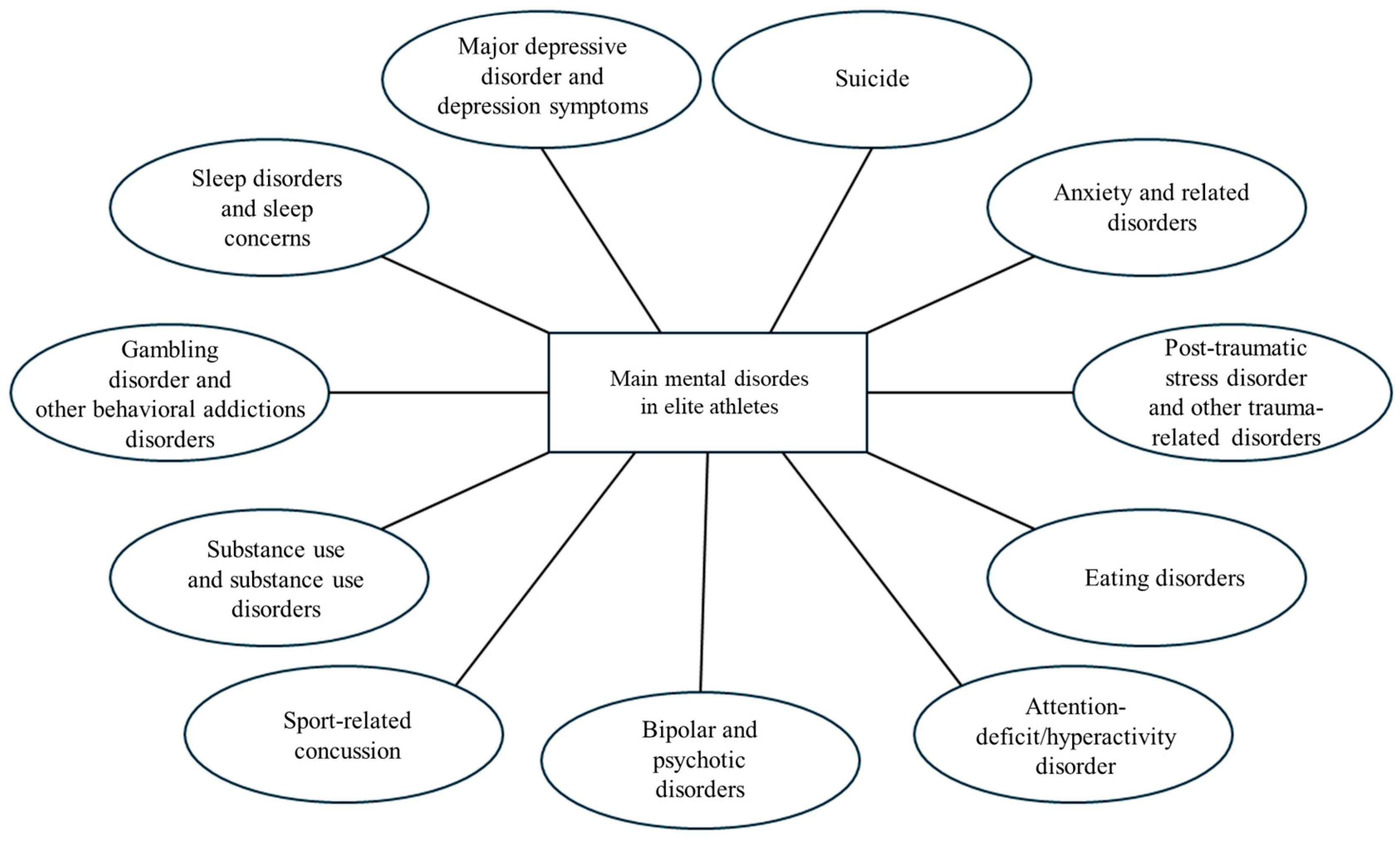
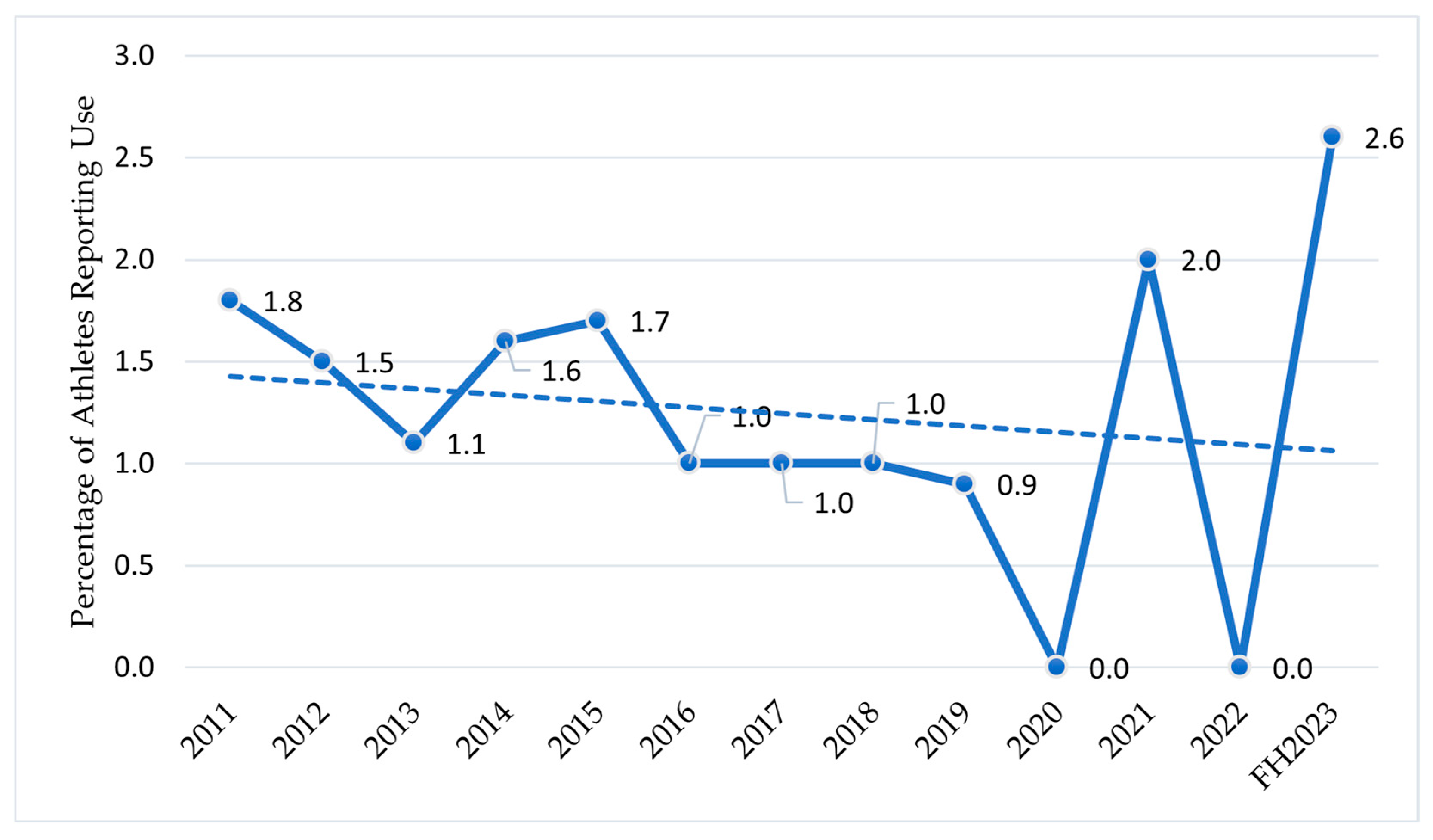
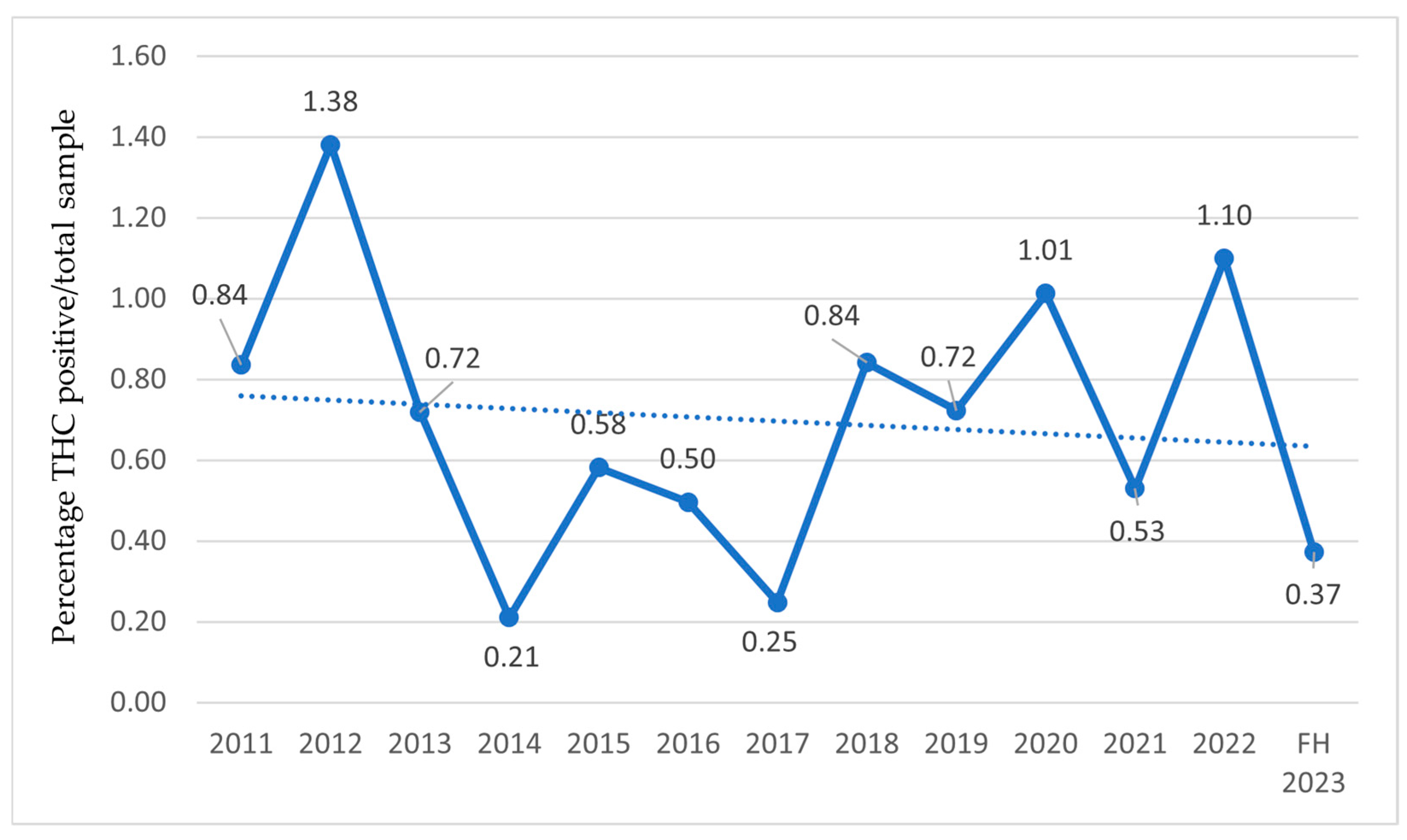
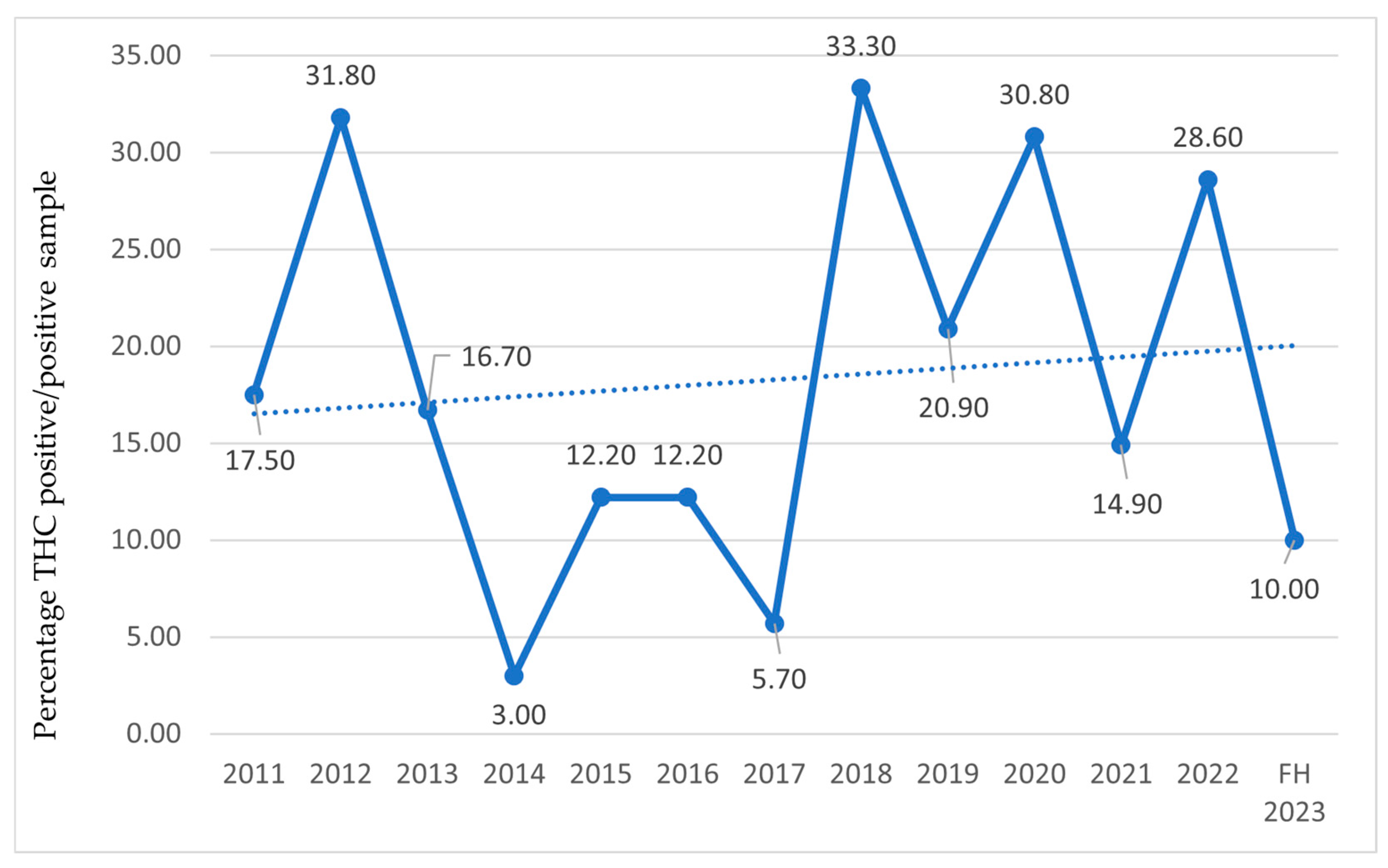
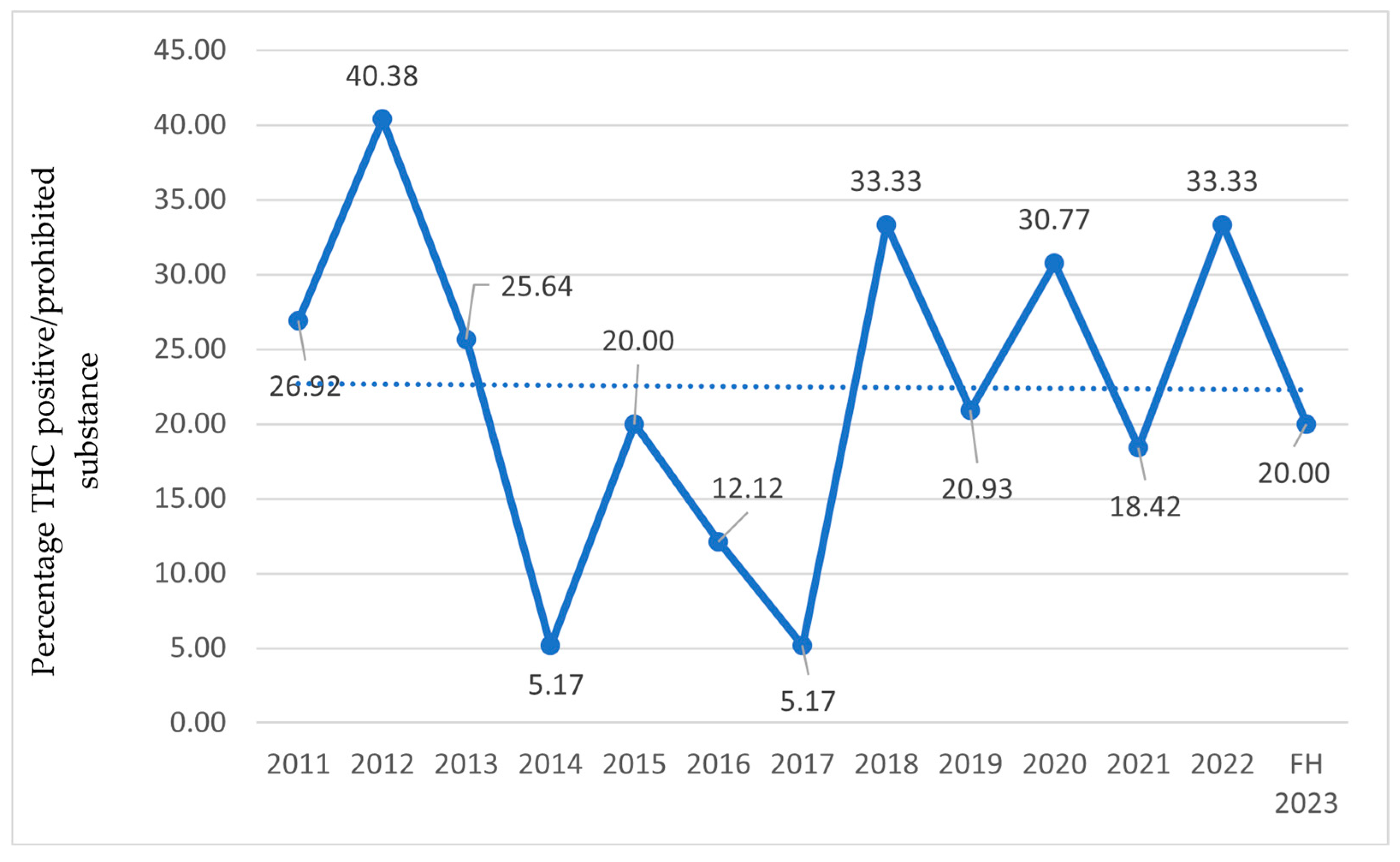
| Year | Athletes Tested for Doping | Non-Doping Drugs Declared | Antidepressants and Anxiolytics |
|---|---|---|---|
| 2011 | 1676 | 1638 | 29 |
| 2012 | 1521 | 1362 | 21 |
| 2013 | 1390 | 1498 | 17 |
| 2014 | 1427 | 1433 | 23 |
| 2015 | 860 | 864 | 15 |
| 2016 | 806 | 818 | 8 |
| 2017 | 1211 | 1164 | 12 |
| 2018 | 594 | 684 | 7 |
| 2019 | 1245 | 1379 | 13 |
| 2020 | 395 | 375 | 0 |
| 2021 | 1322 | 1377 | 27 |
| 2022 | 364 | 407 | 0 |
| FH2023 | 268 | 352 | 9 |
| Year | Positive Athletes | Substance Prohibited | THC-Positive Athletes | THC-Positive Male | THC-Positive Female |
|---|---|---|---|---|---|
| 2011 | 52 | 80 | 14 | - | - |
| 2012 | 52 | 66 | 21 | - | - |
| 2013 | 39 | 60 | 10 | 9 | 1 |
| 2014 | 58 | 101 | 3 | 2 | 1 |
| 2015 | 25 | 41 | 5 | 5 | 0 |
| 2016 | 33 | 22 | 4 | 4 | 0 |
| 2017 | 58 | 30 | 3 | 3 | 0 |
| 2018 | 15 | 13 | 5 | 5 | 0 |
| 2019 | 43 | 33 | 9 | 9 | 0 |
| 2020 | 13 | 9 | 4 | 4 | 0 |
| 2021 | 38 | 47 | 7 | 6 | 1 |
| 2022 | 12 | 14 | 4 | 4 | 0 |
| FH2023 | 5 | 5 | 1 | 1 | 0 |
| Rationale for Use | Risks and Concerns | ||
|---|---|---|---|
| Anxiety Reduction | To manage pre-competition anxiety or general anxiety disorders, which can negatively impact focus, decision making, and muscle tension. Sports where athletes are judged, such as gymnastics or figure skating, may be particularly anxiety-inducing [57,58]. | Addiction and Abuse | Benzodiazepines have a known potential for dependence and addiction, even at therapeutic doses. Case studies have reported athletes developing severe benzodiazepine addiction [59]. |
| Sleep Enhancement | To combat insomnia, which can be prevalent in athletes due to intense training schedules and competition stress, aiming for better recovery [60]. | Adverse Effects | Besides the performance-related side effects, long-term use can lead to impaired psychomotor and cognitive functioning. Overdose and withdrawal can also have severe complications. Increase in the risk of adverse drug interactions [61]. |
| Muscle Relaxation | Some athletes believe benzodiazepines can aid in muscle relaxation and recovery from intense training [62,63]. | Masking Pain and Injuries | By reducing anxiety and potentially masking pain, athletes might not recognize or address injuries appropriately, leading to further harm [64]. |
| Pain Management | Although primarily anxiolytic, they might be used for their muscle-relaxant properties in pain management [61,64]. | Lack of Scientific Evidence for Benefits | There is limited scientific evidence supporting the notion that benzodiazepines improve athletic performance or recovery [5,65]. |
Disclaimer/Publisher’s Note: The statements, opinions and data contained in all publications are solely those of the individual author(s) and contributor(s) and not of MDPI and/or the editor(s). MDPI and/or the editor(s) disclaim responsibility for any injury to people or property resulting from any ideas, methods, instructions or products referred to in the content. |
© 2025 by the authors. Licensee MDPI, Basel, Switzerland. This article is an open access article distributed under the terms and conditions of the Creative Commons Attribution (CC BY) license (https://creativecommons.org/licenses/by/4.0/).
Share and Cite
Ruggiero, M.; Ferrante, L.; Tafuri, D.; Meccariello, R.; Mazzeo, F. Trends in Antidepressant, Anxiolytic, and Cannabinoid Use Among Italian Elite Athletes (2011–2023): A Longitudinal Anti-Doping Analysis. Sports 2025, 13, 233. https://doi.org/10.3390/sports13070233
Ruggiero M, Ferrante L, Tafuri D, Meccariello R, Mazzeo F. Trends in Antidepressant, Anxiolytic, and Cannabinoid Use Among Italian Elite Athletes (2011–2023): A Longitudinal Anti-Doping Analysis. Sports. 2025; 13(7):233. https://doi.org/10.3390/sports13070233
Chicago/Turabian StyleRuggiero, Mario, Leopoldo Ferrante, Domenico Tafuri, Rosaria Meccariello, and Filomena Mazzeo. 2025. "Trends in Antidepressant, Anxiolytic, and Cannabinoid Use Among Italian Elite Athletes (2011–2023): A Longitudinal Anti-Doping Analysis" Sports 13, no. 7: 233. https://doi.org/10.3390/sports13070233
APA StyleRuggiero, M., Ferrante, L., Tafuri, D., Meccariello, R., & Mazzeo, F. (2025). Trends in Antidepressant, Anxiolytic, and Cannabinoid Use Among Italian Elite Athletes (2011–2023): A Longitudinal Anti-Doping Analysis. Sports, 13(7), 233. https://doi.org/10.3390/sports13070233









